Poultry, Fisheries & Wildlife Sciences
Open Access
ISSN: 2375-446X
ISSN: 2375-446X
Research Article - (2021)Volume 9, Issue 10
Kerala is a maritime state located in the western region of peninsular India. The state is blessed with a coastline of 590 Kilometers, Continental shelf of 40,000 Sq Km, EEZ of about 2.18 Lakh Sq Km, large area of backwaters and inland water bodies. Kerala has a significant fisheries sector that has long been an importance source of occupation and livelihood for the coastal population of the state. Kerala contributes about 13% of national marine fish production. So this area needs good attention for the sustainable exploitation of fishery resources and for the welfare of fishermen community. In this report we are trying to figure out the presence of marine and inland fisheries activities of two villages and role of fishery institution in the fisheries sector of Kerala.
Fishermen; Fisheries; Gill netter; Purse seine
Kuzhuppilli fisheries village is located in ward 12 of Kuzhuppilli Gram Panchayat. The village has a total of 60 houses and 70 households are living there (Figure 1). Among them, 10 households are landless or presently living as a joint family. Regarding the housing situation in the village, it is noted that 16.67% houses are pucca, 33.33% are semi-pucca and 50% houses are kachha houses. About 91.67% of the existing houses in the village have sanitary toilets. Safe drinking water is available to 73.33% of the existing houses. More than half of the houses in the village (58.33%) are electrified. It is noted that 58 persons from the fisher folk community are insured with the Fisheries Board (Matsya Board). And 11 persons are covered under the old age pension scheme and 6 persons are covered under widow pension scheme during 2007- 08 in this village.
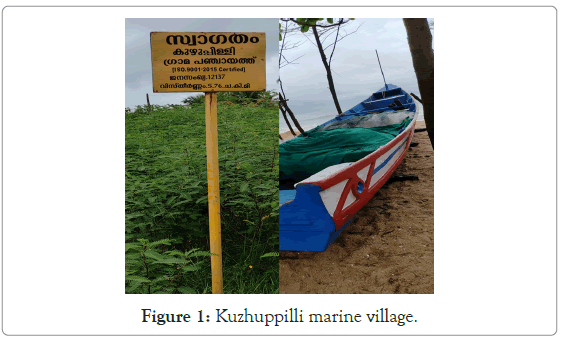
Figure 1: Kuzhuppilli marine village.
Regarding the community specific facilities, this village has no hospital facility. The village has one UP school and one High School [1-3]. Two anganawadis are functioning in this village and one of them are functioning in own building. This village has a network of 6 roads of length 12.87 Km. The village has 25 street lights and only six of them are functional. About the fisheries specific infrastructure and facilities, it is noted that 20 country fishing boats are available in this fisheries village. And a total of 42 kerosene permits are issued to the fisher folk in this. The village has one ice plant. The village has a protected coastal length of 1.75 Km. Consumption of liquor and narcotic drugs are moderate in this village. Most of the people in this village depend on fishery related activities for their livelihood. Entire fishing operations are carried through Munambam Fishery Harbour (Figure 2). Fishermen are settled along the coastline and are actively engaged in fishing operation. The COVID-19 pandemic has seriously affected the life of fisherman in this village and now they are trying to recover from it [1,2].
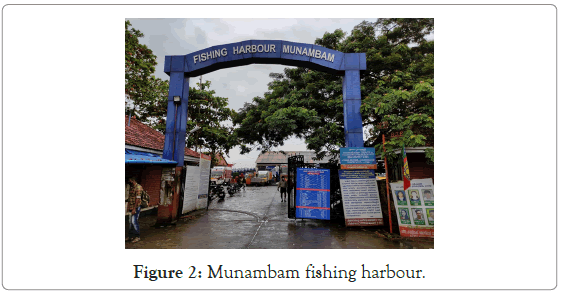
Figure 2: Munambam fishing harbour.
Munambam fishing harbour
We reached harbour by 6 AM (September 2021). An entry fee of Rs.10 per person was charged. The catch was comparatively low. The major catch included Kingfish, Sailfish, Tunas, Sharks, Leatherjacket, Priacanthus hamrur, Parapenaeopsis stylifera, Metapenaeus dobsonii, Metapenaeus monoceros, Portunus sanguinolentus, squids and so on (Table 1). Photographs of commercially important fishes had taken. Moreover we had some interactive time with the fishermen about the fishing vessels and gears used in the area [3]. These include mainly gill netter, stern trawler, purse seiner and gillnet, trawl net respectively [4,5].
| Species found (Includes minor and major catches) | |
|---|---|
| Sardinella gibbosa Order: Clupeiformes Family: Clupeidae Common name: Goldstripe sardinella |
Nemipterus japonicas Order: Perciformes Family: Nemipteridae Common name: Japanese threadfin bream |
| Sphyraena jello Order: Perciformes Family: Sphrynidae Common name: Barracuda |
Epinephelous diacanthus Order: Perciformes Family: Serranidae Common name: Spinycheek grouper |
| Decapterus russelli Order: Perciformes Family: Carrangidae Common name: Indian scad |
Megalapsis cordyla Order: Perciformes Family: Carrangidae Common name: Torpedo scad |
| Johnius glaucus Order: Perciformes Family: Scianidae Common name: Pale spotfin croaker |
Nibea maculate Order: Perciformes Family: Scianidae Common name: Bloched croaker |
| Amblygaster sirm Order: Clupeiformes Family: Clupeidae Common name: Spotted sardinella |
Atropus atropos Order: Perciformes Family: Carrangidae Common name: Cleftbelly trevally |
| Auriglobus nefastus ( Roberts, 1982) Order: Tetraodontiformes Family: Tetraodontidae Common Name: Green bottle puffer fish |
Dactylopterus orientalis (Cuvier, 1829) Order: Scorpaeniformes Family: Dactylopteridae Common Name: Oreintal Flying gurnard |
| Scomber indicus Order: Perciformes Family: Scombridae Common Name: Indian chub mackerel |
Rhynchobatus species Order: Rhinopristiformes Family: Rhinidae |
| Fistularia petimba Order: Syngnathiformes Family Fistulariidae Common Name: Red cornet fish |
Istiophorus species Order: Istiophoriformes Family: Istiophoridae Common Name: Sail Fish |
| Sardinella longiceps Order: Clupeiformes Family: Clupeidae Common name: Indian Oil Sardine |
Rastrelliger kanagurta Order: Scombriformes Family: Scombridae Common name: Indian Mackerel |
| Parastromateus niger Order: Carangiformes Family: Carangidae Common name: Black Pomfret |
Scomberomorus commerson Order: Scombriformes Family: Scombridae Common name: Narrow-barred Spanish mackerel |
| Euthynnus affinis Order: Scombriformes Family: Scombridae Common name: Kawa Kawa |
Thunnus orientalis Order: Scombriformes Family: Scombridae Common name: Pacific Blue Fin Tuna |
| Rhinoptera javanica Order: Myliobatiformes Family: Rhinopteridae Common name: Flapnose Ray |
Stolephorus indicus Order: Clupeiformes Family: Engraulidae Common name: Indian Anchovy |
| Monodactylus argenteus Order: Perciformes Family: Monodactylidae Common name: Silver Moony |
Cynoglossus semifasciatus Order: Pleuronectiformes Family: Cynoglossidae Common name: Bengal tonguesole |
| Caranx melampygus Order: Carangiformes Family: Carangidae Common name: Blue Fin Travally |
Squalus mitsukurii Order: Squaliformes Family: Squalidae Common name: Shortspine Spurdog |
| Balistes capriscus Order: Tetraodontiformes Family: Balistidae Common name: Grey Trigger Fish |
Mene maculate Order: Carangiformes Family: Menidae Common name: Moon Fish |
| Priacanthus macracanthus Order: Perciformes Family: Priacanthidae Common name: Red Bigeye |
Lepturacanthus savala Order: Perciformes Family: Trichiuridae Common name: Savalai Hairtail |
| Cephalopods | |
| Sepia pharaonic Order: Sepiida Family: Sepiidae Common name: Pharaoh cuttle fish |
Uroteuthis duvauceli Order: Teuthida Family: Loliginidae Common name: Indian squid |
| Octopus vulgaris Order: Octopoda Family: Octopodida Common name: Common octopus |
|
| Crustaceans | |
| Paeneus monodon Fabricus, 1798 Order: Decapoda Family: Solenoceridae Common Name: Giant tiger prawn |
Fenneropenaeus indicus (Milne Edwards, 1837) Order: Decapoda Family: Penaeidae Common name: Indian Prawn |
| Parapenaeopsis stylifera (Milne Edward, 1837) Order: Decapoda Family: Penaeidae Common name: Kiddy shrimp |
Metapenaeus affinis (Milne-Edward, 1837) Order: Decapoda Family: Penaeidae Common name: Jinga shrimp |
| Portunus sanguinolentus (Herbst, 1783) Order: Decapoda Family: Portunidae Common name: Three-spot swimming crab |
|
Table 1: The species found are (Includes minor and major catches).
Catch composition
Here the entire marine fishery operation in nearby areas is carried out. The infrastructures available in Munambam fishing harbour includes wharf and auction halls, net mending shed, ice plant, administrative block, locker rooms, gate and gate house, Vessel monitoring room, overhead tank and ground level tank, packing area and loading area [3].
The harbour is under the Department of Harbour Engineering, Kerala. There were about 5 to 50 crafts operated each day from this harbor and average daily landing is about 100 to 154 ton (Tables 2-4).The mode of sale is through auctioning and a major part of fishes called as “mix” which includes small and medium sized fishes which are used to make value added products like fish meal, fish oil (mainly), poultry fertilizer, toothpaste ingredient etc. after transporting to the chemical factories and which is carried out under the supervision of representative from the state fisheries department (Figure 3) [6-8]. The Covid pandemic has caused further decrease in the fish landing from this harbour.
| Species landed | Average quantity in kilograms |
|---|---|
| Indian mackerel | 18,305 |
| Japanese threadfin bream | 2,100 |
| Sail fish | 910 |
| Grouper | 1,050 |
| Sole fish | 700 |
| Stingray | 600 |
| Tuna | 1,610 |
| Squid | 5,180 |
| Shrimp | 1,400 |
| Octopus | 1,330 |
| Seer fish | 1,350 |
| Mix (all small and medium sized fishes ) | 1,05,400 |
| Total | 1,39,935 |
Table 2: Quantity of species landed on day one (data from harbor division).
| Species landed | Average quantity in kilograms |
|---|---|
| Yellow fin Tuna | 1,520 |
| Shrimp | 4,655 |
| Large Squid foe export | 10,350 |
| Small Squid for export | 450 |
| Sail fish | 1,715 |
| Indian Mackerel | 2,800 |
| Mix ( all small and medium sized fishes ) | 88,815 |
| Total | 1,10,305 |
Table 3: Quantity of species landed on day Two (data from harbor division).
| Species | Price per Kg |
|---|---|
| Tuna | 200-350 |
| Shark | 350-500 |
| Sail fish | 150-450 |
| Pomfret | 400 |
| Threadfin bream | 160-170 |
| Red big eye | 150-240 |
| Sole Fish | 240 |
| Anchovy | 200 |
| Grouper | 500 |
| Chanos sp. | 300 |
| Seer fish | 600 |
| Portunus crabs | 200 |
| Indian mackerel | 150 |
| Penaeus indicus | 300 |
| Squid | 280 |
| Trevally | 200-250 |
Table 4: Market price for the species at Munambam harbor.
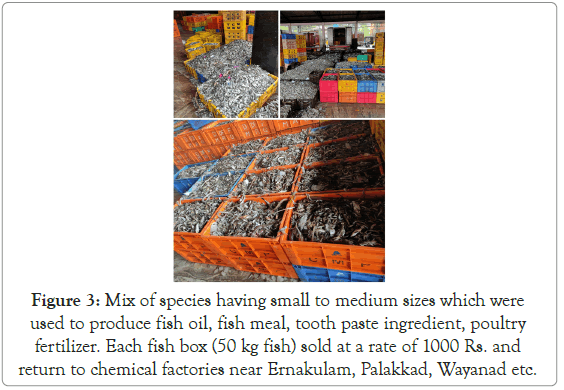
Figure 3: Mix of species having small to medium sizes which were used to produce fish oil, fish meal, tooth paste ingredient, poultry fertilizer. Each fish box (50 kg fish) sold at a rate of 1000 Rs. and return to chemical factories near Ernakulam, Palakkad, Wayanad etc.
Crafts operated
Munambam fishing harbor is one of the well-developed harbor with all the required facilities in Ernakulam. Usually public auction system is carried out for the catch. The construction of Munambam harbor was started in the year 1992 was completed in the year 1998. The area of harbor is around 3 ha and the construction cost was estimated to be Rs.16 crores. 50% of the expenditure was met by the Central government. The harbor is working under the harbour engineering division of the Kerala government. The major crafts at Munambam where trawler, purse seiner and gill netter [3,4,7,9]. The fishermen allowed to enter the vessel and explained details regarding the fishing procedure.
A significant part of the catch is contributed by trawlers. Stern Trawlers are mainly operated. Purse seine boats are also bringing catch to the harbor. In addition to this small thermo-coal boat, canoes and vallom etc. operate in these areas. The length of the motorized boat is 26-27 feet. The breadth varies between 4-5 feet and draft is 3 feet. Most of the motorized boats have outboard engines of Yamaha or Suzuki with a capacity of 9.9 HP [7,8]. Usually operates up to a distance of 300-400 km. Crew consist of 7-10 members. Hull is made of wood. Traditional nets like Ayalavala, Chalavala, Aavolivala, Veloorivala and Choodanvala are mostly operated here.
Kattamaram is one of the oldest fishing craft widely used by the marine fisher folk of this village. This primitive type of fishing mode can be easily assembled by joining two or three wooden planks by steel ropes. It can be propelled by propelling engine also. Mainly two types of catamarans but of different sizes are sailing from the shore of this village. The one which is 8-9 m in length will accommodate four persons. The other is 5-8 m length and 1-1.5 m width can carry only two persons (Tables 4-6). The cost of such catamarans varies according to the nature of the wood used.
| Traditional fibre canoe | |
|---|---|
| Length over all (LOA) | 8 to 9 m |
| Depth | 800 cm |
| Beam | 1.5 m |
| No. of seats | 8 to 9 |
| No. of fish hold sections | 5 to 6 |
| Material used for construction | Wild jack wood |
| OB engine | |
| Company | Yamaha, Suzuki, Toyan, Mariner |
| Power | 9.9 HP |
| Capacity | 26 litre |
| Fuel | Two types A. Petrol only B. Combination of petrol and kerosine |
| Fuel consumption | 7 L fuel per 1 hour trip |
| Price | Yamaha A. 2 stroke-1.35 lakh B. 4 stroke-1.8 lakh Suzuki A. 2 stroke-1.16 lakh B. 4 stroke-1.6 lakh |
| No. of fishers going per canoe | 4 to 6 |
Table 5: Traditional fibre canoe/ Vallom with OB engine- Type 1.
| Traditional vallom | |
|---|---|
| Length over all (LOA) | 5 to 8 m |
| Depth | 650-800 cm |
| Beam | 1-1.5 m |
| No. of seats | 6 to 9 |
| No. of fishhold sections | 5 to 6 |
| Material used for construction | Mango, Wild jack, Bur flower |
| OB engine | |
| Company | Yamaha, Suzuki |
| Power | 2, 2.2 HP |
| Capacity | 5 to 15 litre |
| Fuel | Two types A. Petrol only B. Combination of petrol and kerosine |
| Price | Yamaha-55,000 Rs. Suzuk-49,800 Rs. |
| No. of fishers going per canoe | 2 |
Table 6: Traditional Vallom with OB engine -Type 2.
Trawlers
Trawlers present in the area where generally smaller boats with 5-6 person (Figures 4 and 5). They start their voyage by 5 am in the morning and return by 4 pm. The length of the boat was 10 m with 2.88 m width and 2 m drift [10]. The engine used was Ireland engine with horse power of 68. The Boat was constructed using wood.
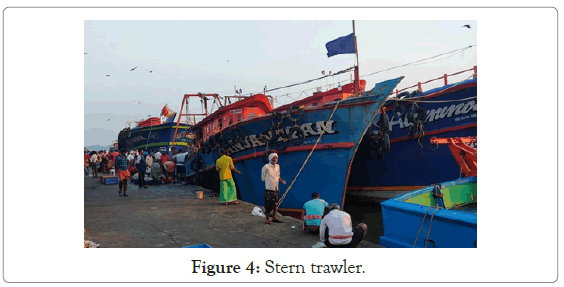
Figure 4: Stern trawler.
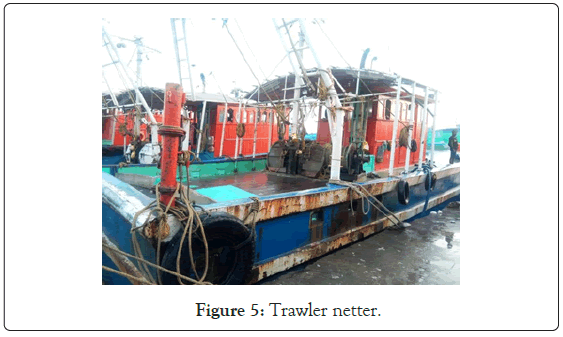
Figure 5: Trawler netter.
Deck equipments present where mast, boom, pulley, anchor, wheelhouse, winch and otter board. They possess a GPS and 10 ice boxes each with a capacity of 600 kg. Trawlers are mainly 2 types-one with trawls used for catching prawns mainly others with different trawls for prawns and squid. The material used for trawl was HDPE. The mesh size varies from code end to wing as follows: code end-1/2 inch, throat-1/2 inch, wings-8 inch [11,12].
Floats are made of PVC with a size of 300 mm. Sinkers used where 2 types one is lead with cylindrical shape and other with lead pieces. Each weighs about 100 g weight. Lead sinkers of 25 g each with a total weight of 15-19 kg are also used depending upon the depth of operation. 15 m rope is used in their trawl. The otter boards used where of Mangoli type with rectangular shape and weigh about 52 kg. The trawl is provided with a high speed winch for the operation.
The major catches were F. indicus, M.dobsonii, P.monodon and P. stylifera. Fishing season mainly starts from August. Karikkadi is mainly caught during April-January. In the case of trawlers which use combination of gear, the mesh size of the squid trawls where 2-5 mm and major season was August-December.
Purse seiners
All the purse seiners are operated in vallom or motorized craft where actually ring seiners operated in vallom or motorized craft. They generally go for single day operation with a maximum number of 60% during season. They start their voyage by 5 am and come back 4 pm. The length of the craft was 1 m. They use 240 Hp engine. They possess a winch, derrick.
The duration of voyage is single day. The material of construction is iron. The overall length in meter is 1316.48 m and length of 4.2 m. The draft is 1-1.5 m. Another craft has its material made of wood, the overall length is 108 m and beam is 2.88 m. The draft is 2 m. Purse seines which were made up of nylon whose length was 500 m and mesh size 18 mm [13-16]. There where Trawls which were made up of HDPE whose length is 12 m. The species caught where Sardine, Mackerel. General suggestion about the harbour is that the landing center is small and facilities are less.
Gill netter
Gill netter also termed as GN boats. Around 20 numbers of boats landed daily. Overall length of vessel ranges from 15-20 m. Each boat generally had an average fishing period of 20-30 days at sea. The vessel had wheel house in the aft part [1]. Fish hold and working deck is located at the foreword part. The gear is stacked and covered with plastic sheets at the forward part. Monofilament Tuna Long Line is also used as a gear (Figure 6).
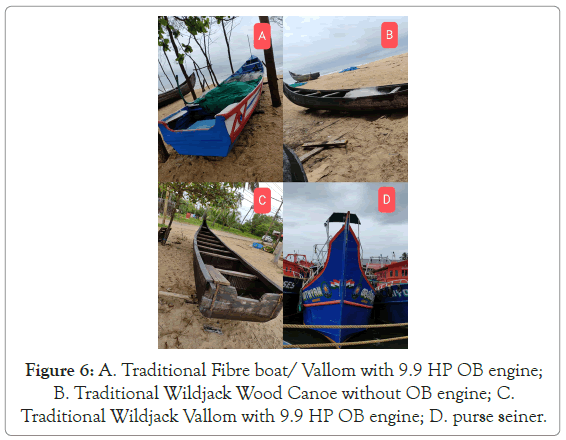
Figure 6: A. Traditional Fibre boat/ Vallom with 9.9 HP OB engine; B. Traditional Wildjack Wood Canoe without OB engine; C. Traditional Wildjack Vallom with 9.9 HP OB engine; D. purse seiner.
Gears used
Fishing gears are vast and varied which has specific application depending upon the type of fish to be captured [1,2]. Along with the modern type of fishing gears, there are also traditional fishing gears which are in wide use.
Trawl nets
Significant portion of the landing is caught by trawl net. It is operated from mechanized trawlers and has mesh mouth opening of about 30 to 35 m. The code end mesh size is 1.8-2.5 cm and these are usually operated at a depth of 50-100 meters. Fish trawls and shrimp trawls are there (Figures 7 and 8).
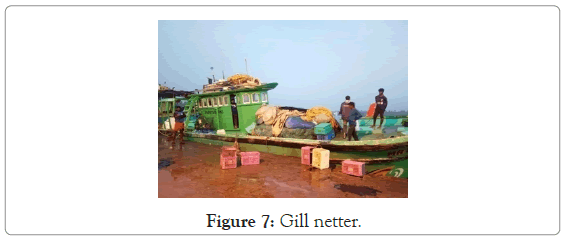
Figure 7: Gill netter.
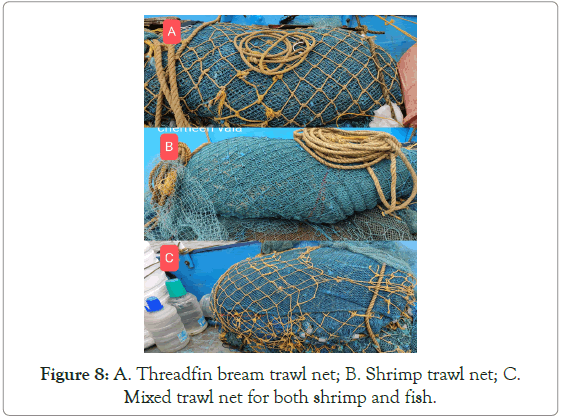
Figure 8: A. Threadfin bream trawl net; B. Shrimp trawl net; C. Mixed trawl net for both shrimp and fish.
Trawl nets are used in trawlers, either in side trawlers or stern trawlers. They vary in size from small open boats to large factory trawlers. Side trawlers are operated in very far fathoms while stern trawlers are in commonly used. The trawl net will vary in accordance with the targeted species. Trawl is a bag net towed through water to caught the fishes, the mouth being open throughout the operation. It is the otter board (used in pairs), which keep the mouth of trawl horizontally open during towing. The otter board is attached to the winch with the help of warp wires. The length of the warp wire will differ on how deep the trawl operation is done [17]. It is the responsibility of the captain (‘srank’) to guide the workers. In a trawler of 80 feet, accommodates about 10 workers. The operation starts when the trawl net is attached to the stern side (to the winch) and the net will throw into the water. The vessel will start to tow, the maximum towing time is 2 hours and about 4 towing will take place in a day. During the towing, the fishes will accumulate in the cod end of the trawl which can be collected at the end of the process.
Gillnets
These are used both inshore and offshore which have large rectangular mesh nets. These are generally kept close to the shore. The front portion of the net is kept open and fish swims into the net and are tangled by the mesh. The type of the fish caught by this gear is cod, tuna, sword fish etc.
The gillnet fishing is a traditional practice of fishing by the artisanal fishermen of Kerala. Commercial fishing with gillnets can also be found both in Inland and Marine sectors. It is generally a night based fishery since the fishes are mostly pin down or entangled in gillnet during night time [1]. The gillnets are long (about 500 fathoms) nets made of vertical panels of netting that hang from a line having floaters at regular intervals and the bottom line of the net is normally weighted with lead. Gillnets differ in its mesh size, color and the type of filament with which the gill net is made (Tables 7 and 8).
| Fish species | Gill net mesh size (mm) |
|---|---|
| Mackerel | 46, 48, 50 |
| Sardine | 32,34,36 |
| Pomfret | 90, 100, 105 |
| Anchovy | 24 |
Table 7: Table showing gill net mesh sizes for various fish species.
| Traditional trammel net | |
|---|---|
| Total length | 3250 m |
| Depth of net | 5 to 7.5 m |
| Thickness | 1 mm |
| Outer layer mesh size | 150 mm |
| Inner layer mesh size | 48 mm |
| Sinker | loading wire( 600 Rs./75 m) |
| Floaters | Plastic circular floats 250 to 300 (8 Rs./piece) |
| Target species: | Except small sardines and anchovies, all fishes were caught |
Table 8: Specification of traditional trammel net.
A small vessel (gill netter) carrying 5 workers will start the operation at about ‘5’ in the evening in such a manner that one end of the net will be in the vessel and the other end will be far away (500 fathoms-the length of the net), with a flag to recognize the end of the net and the main body of the net will be simply lay in the deep like a wall. Once the fishes got pass over there will entangle in the twines (either the gills or fins). The workers will then pull the net at 2 am in the morning to finish the operation since the hauling of net to the vessel is a time consuming process. The fishes caught in the net are removed manually (Figures 9-12).
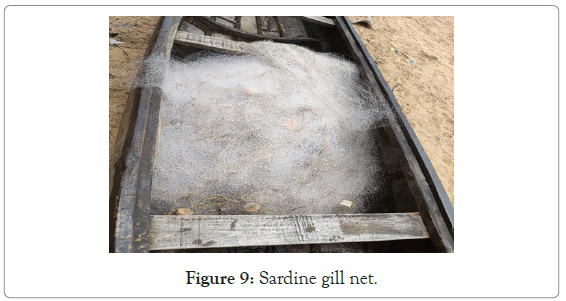
Figure 9: Sardine gill net.
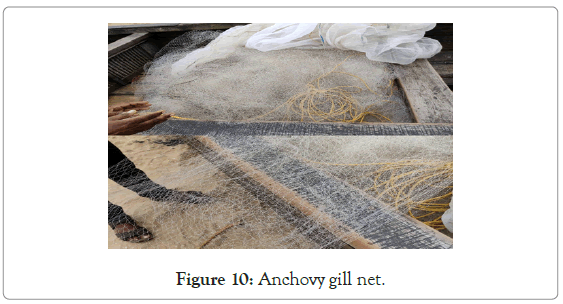
Figure 10: Anchovy gill net.
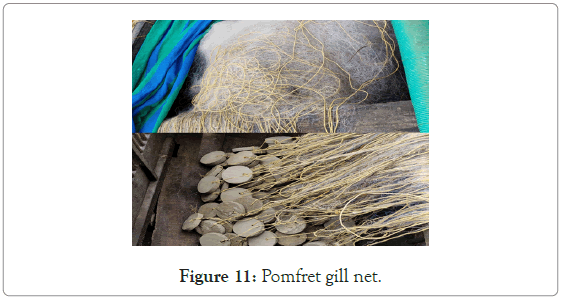
Figure 11: Pomfret gill net.
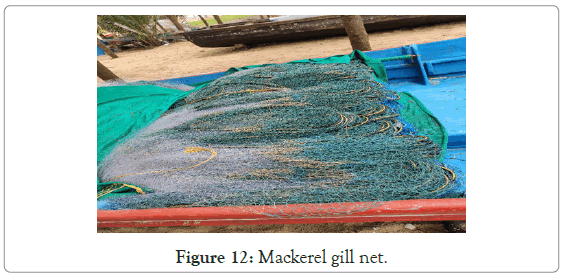
Figure 12: Mackerel gill net.
Purse seine
Purse seine is one of the most efficient and advanced fishing methods. Operation of purse seine nets have been reported in Kerala coast from late 1978 with 10 units of purse seine gear in Cochin Backwaters [17]. It mainly aims at the pelagic schools which can be identify by our naked eyes, In shallow waters the fishermen uses their convention wisdom in finding the schooling pelagic fishes by observing the change in the color of patches or bubbles developed by schooling fishes while acoustic fish detection using echo sounders done at deeper water [18].
A purse seine is a long net with float line and lead line in the upper and lower edge respectively with hanging purse rings through which a purse line which is normally a rope runs through, to pursing the net during the operation. Generally purse seines are used in purse seiners of about 90-95 feet, accommodating a maximum of 30 workers.
Small scale operations are also possible with small purse seiners. The boat which assist in purse seining locally known as ‘dingi’ is introduced in to water to help in encircling the school immediately after identifying the schools by the fishermen. The dingi boat with two fishermen onboard carries an end of purse seine net and meanwhile the large boat encircles the shoal at greater speed so that the school will get entrapped inside the purse formed by the purse seine net (Figure 13).
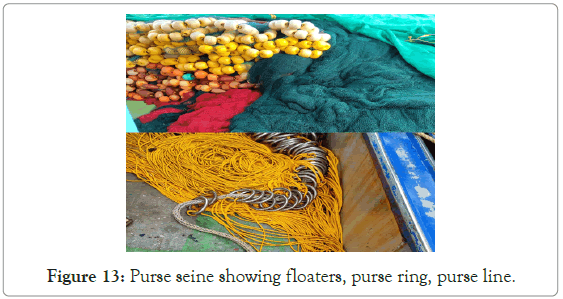
Figure 13: Purse seine showing floaters, purse ring, purse line.
The gear can be made into purse as the purse line is hauled in with the help of purse line which commonly known as Pursing. Another technique held in this is the collection of fish. The moving Derrick will come over the purse seine net and the collecting net (‘maali’ in fisherman language) hanged in the derrick with the help of two pulleys will get loaded manually. The base of the collecting net loaded with catch will untie on wherever they want to deposit it [4,7,8].
Hooks and lines
This is a traditional method of fishing and has its use in places where other methods of fishing become difficult. This is quite ideal when the waters are deep and the grounds are uneven. The size of the hooks depends on the depth which the line can be sunk.
Long line
It is also commonly used. This is consisting of a master line with several branches and a number of hooks could be adjusted depending upon the length of line and its branches. Usually they went for 10 day fishing with 23 persons on vessels.
Trammel net
Compared to gill nets, trammel nets sometimes show poorer selectivity because of the tangling characteristics of the three layers of netting compared to the single layer of a gill net. By catch is usually minimized by the skipper’s knowledge of the grounds and by him shooting his gear where he expects there to be an abundance of the target species with minimum by-catch (Figure 14).
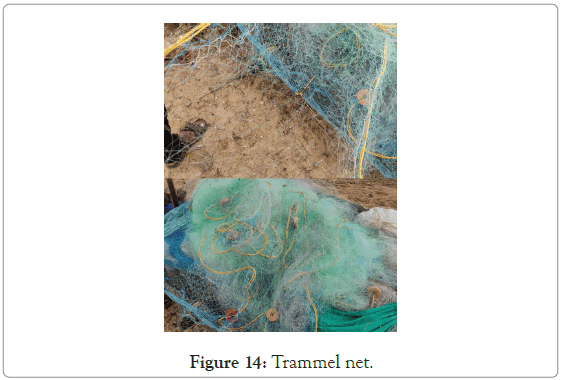
Figure 14: Trammel net.
The recorded data on the technical specifications catch composition, selectivity and operation of the conventional fishing technique rehearsed in Kuzhuppilli marine fishing Village and Munambam harbour, Ernakulam, Kerala would serve as base line information for the technological modifications the method may go through in the coming years.
Author wish to thank the authorities of Kerala University of Fisheries and Ocean Studies, Panangad, 682505 Kerala, India ( Especially Mrs. Amrutha R krishnan) for giving the essential facilities, and their thoughtful support and direction throughout the investigation.
The author declares that there is no conflict of interest.
There is no funding source available.
Citation: Ajay VS (2021) Investigation of Different Fishing Gears and Crafts Operated along the Marine Coast of Kuzhuppilli Village, Ernakulam, Kerala with Special Reference to Munambam Harbour. Poult Fish Wildl Sci. 9:227.
Received: 20-Sep-2021 Accepted: 04-Oct-2021 Published: 11-Oct-2021 , DOI: 10.35248/2375-446X.21.9.227
Copyright: © 2021 Ajay VS. This is an open-access article distributed under the terms of the Creative Commons Attribution License, which permits unrestricted use, distribution, and reproduction in any medium, provided the original author and source are credited.